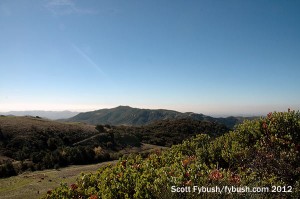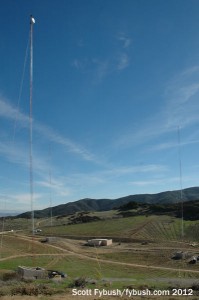NorthEast Radio Watch 11/18/2024: Sims Gets Yankees Callup
In this week’s issue… Yankees hire Dave Sims - Wallace, Maxwell move in NYC - Gray cuts news in Maine - Remembering CT's Pinto By SCOTT FYBUSH Jump to: ME - NH - VT - MA - RI - CT...
Text and photos by SCOTT FYBUSH
This week’s installment marks another in an ongoing series from our “Things that Won’t Be There Much Longer” tour of 2012. If you’ve been following along, you know that there were three things we were determined to see before 2013 began: the old KXAS-TV studios in Fort Worth, Texas, the KMOX studios near the Gateway Arch in St. Louis, and KBRT’s Catalina Island transmitter site off the California coast.
Having seen the island home KBRT was about to vacate, we couldn’t leave southern California on that December 2012 trip without making the other half of the trip, up to the mountaintop site from which KBRT was about to begin its new on-shore existence. (Also, it was December, and we really didn’t want to leave southern California at all if we had any choice in the matter!)
Our story so far, if you’ve missed it: after 60 years blanketing the south coast (by day, anyway) from 20-some miles offshore in the rugged hills of Catalina Island, Crawford Broadcasting’s KBRT (740) was facing the imminent loss of the transmitter site it leased from the conservancy that owns most of the island. The AM experts at Crawford spent several years scouring southern California for a site where they could erect new towers, provide a comparable signal over the Los Angeles basin, and avoid all of the headaches that came with a transmitter site so far from civilization.
In this NIMBY-ridden era, that wasn’t an easy task, and Crawford tried and rejected several possibilities before settling on a site called Oak Flat, up in the mountains that separate eastern Orange County from Corona. This was actually a recycled site: it had been the original home of KPLS (830 Orange) before that station moved to a site lower down on the Corona side, where it’s now KLAA. (We saw it, at least from the outside, on an earlier trip.)
When KPLS left, it left: the three towers the station had used were dismantled, the ground system was removed and the site was left pretty much empty when Crawford got it.


By the time we visited in December 2012, the Crawford team had done a remarkable job of building something where once there was nothing.
This is an incredibly remote site, considering how close it is to the incredibly dense populations of Orange and Riverside counties. But all those millions of people down in the valleys are separated by some pretty intense hills, and getting up to this site requires a drive over those hills into Corona, navigating our way right to the edge of suburbia, then past a stout gate and up a winding fire road that takes us up to about 2600 feet above sea level, where we see the new KBRT four-tower array in all its glory. (The distant shot above is from the fire road a bit to the east of the array; that jet behind the towers was on approach to John Wayne Airport down in Santa Ana, I think.)
To call this “Oak Flat” is a bit of a misnomer; while it’s as flat as anything gets up here in the hills, this site is still distinctly sloped, and the array butts right up against a steep hillside, which at least gives us nice views down to the towers and out to the ocean.


As hard as it is to get up here, vandalism is still a huge concern, and so Crawford put in a lot of work and money to harden this site as much as possible. The prefab building housing the new Nautel NX50 transmitter and Kintronics phasor (and eventually, for backup, the Nautel XR12 that had been the main on Catalina) lives behind a sturdy concrete-block wall with tamper-proof hinges on the heavy steel door. Each ATU and tower base is similarly protected – and just for good measure, there’s special graffiti-resistant paint coating the outside of each of those walls.
The new site was pretty much ready to go on the air when we stopped by, and it was just a few weeks later that Crawford officially moved operations from Catalina over here to Oak Flat, bringing with it a boost to 50 kilowatts by day and new 24-hour operation, with 170 watts at night that do a fair job of beaming down from the hills over KBRT’s new city of license of Costa Mesa and some of the rest of Orange County. (It’s still hard to overcome the big 50,000-watt nighttime signal that skips down almost perfectly from KCBS in San Francisco, of course, so most KBRT listeners after dark are still doing so on the stream.)
How about one more bonus visit before we leave greater Orange County? KOCE (Channel 50) started out as a small secondary PBS station in the shadow of LA’s big KCET (Channel 28), but when KCET had its high-profile falling-out with PBS, KOCE took advantage of the opening to rebrand itself as “PBS SoCal,” becoming the big metropolitan PBS station for the region while KCET struggled to find a new place for itself as an independent public broadcaster.
Even before KOCE’s big move to primary PBS in 2011, the station was growing. It had already relocated its offices to the South Coast Corporate Center in Costa Mesa, and in 2012 it moved its studios from Golden West College in its city of license, Huntington Beach (part of the Coast Community College District, its former licensee), to the ground floor of that office complex, just off the 405, 55 and 91 freeways.
This is a simple but efficient facility: there’s one medium-sized studio from which the nightly “Real Orange” newscast originates, and a control room just adjacent. On the day we visited, the station was taping pledge drive segments to run later that evening, which explains why this photo was taken from a darkened phone bank off to the side of the studio.
This new KOCE facility, by the way, is just across the 55 freeway from KBRT’s own longtime studios on Airway Avenue in Costa Mesa, in turn just a block from John Wayne Airport.
Thanks to KBRT’s Bill Agresta and Cris Alexander and KOCE’s staff for the tours!
 The landmark 24th edition of the world-famous Tower Site Calendar is in production, and your support will determine whether it will be the final edition.
The landmark 24th edition of the world-famous Tower Site Calendar is in production, and your support will determine whether it will be the final edition.
It’s been a complicated few years here, and as we finish up production of the new edition (including a cover reveal, coming later this week!), we’re considering the future of this staple of radio walls everywhere as we evaluate our workload going forward.
The proceeds from the calendar help sustain the reporting that we do on the broadcast industry here at Fybush Media, so your purchases matter a lot to us here – and if that matters to you, now’s the time to show that support with an order of the new Tower Site Calendar. (And we have the new Broadcast Historian’s Calendar for 2025 ready to ship, too. Why not order both?)
Visit the Fybush Media Store and place your order now for the next calendar, get a great discount on previous calendars, and check out our selection of books and videos, too!
Next week: A few stops in San Diego, December 2012
In this week’s issue… Yankees hire Dave Sims - Wallace, Maxwell move in NYC - Gray cuts news in Maine - Remembering CT's Pinto By SCOTT FYBUSH Jump to: ME - NH - VT - MA - RI - CT...
In this week’s issue… iHeart axes Boston, NYC morning shows and more - Cumulus cuts in central PA - Southern Tier combo saved from silence - Ottawa FM relaunches - K-Love buys in the Burgh - Scranton gets "Loud" -...
In this week’s issue… "Hot" cools down in Providence, CT studios closed - GBH to sell Cape studios - A HEBA in Hamden? - New HDs in New York - Another Canadian AM to close
In this week’s issue… GBH shuffles mornings, prepares new show launches - NYSBA inducts Hall of Famers - More news-talk in the Hudson Valley - Remembering Dan Sys